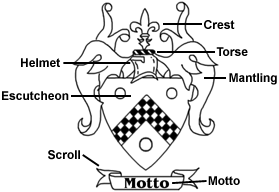Chip Heraldry
|
We have seen just about everything you can imagine on the surface of integrated circuits, so it was no great surprise when we discovered a coat of arms on a Hewlett-Packard microprocessor. This is the first example of "chip heraldry" that we have encountered, and although the exact meaning of this coat of arms escapes us, it must have something to do with the heraldry of the Hewlett-Packard VLSI (Very Large Scale Integration) dynasty. We have been informed by HP engineers that Spectrum was the original name of the PA-RISC (Precision Architecture-Reduced Instruction Set Computing) computer architecture that Hewlett-Packard invented in the mid 1980s and is still using and improving on today. Cheetah and Firefox were the names of the first two computers using this new architecture, and are probably represented in the coat of arms illustrated above (although we are not sure of the exact nature nor meaning of the animals in this coat). 
Typical construction motifs for a classic coat of arms are illustrated in the figure above. Among the necessary elements are a crest, torse, and helmet that act as a "header" for the herald. These elements are encapsulated into a single "crown" on the HP coat, probably indicating the superior or royal nature of this coat. The "mantling" is executed with a cheetah on the left of the shield and a dog or wolf (Firefox) to the right. Both animals are raised in an attack pose. The "scroll" contains the term SPECTRUM and is subtitled: VLSI. Any visitors with additional information about this artwork are encouraged to contact us with pertinent details. Another interesting tidbit of information was passed to us by Hewlett-Packard engineer Rick Butler: It seems that the chip fabrication plants have often discouraged "chip art" because of problems encountered with artifacts during the manufacturing process. Under certain circumstances, small metal features from the artwork can "fall off" the chips during processing and the resulting loose metal can interfere with correct operation of the circuitry. It has been suggested that the small spots on the cheetah might have been the source of these problems when they became displaced during manufacture. |
© 1995-2025 by Michael W. Davidson and The Florida State University. All Rights Reserved. No images, graphics, software, scripts, or applets may be reproduced or used in any manner without permission from the copyright holders. Use of this website means you agree to all of the Legal Terms and Conditions set forth by the owners.
This website is maintained by our
|
